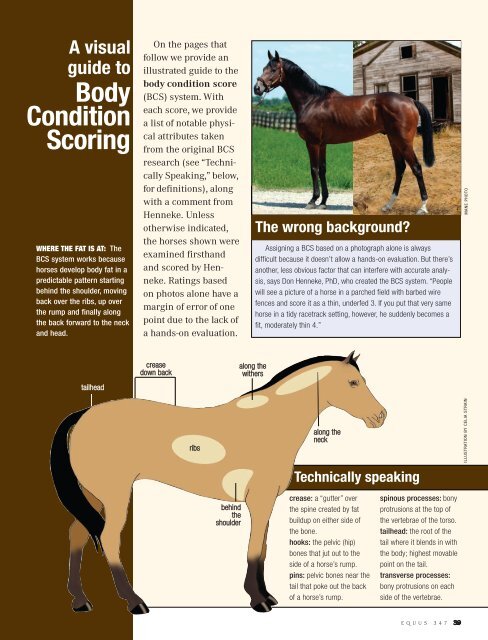You also want an ePaper? Increase the reach of your titles
YUMPU automatically turns print PDFs into web optimized ePapers that Google loves.
A visual<br />
guide to<br />
Body<br />
Condition<br />
Scoring<br />
WHERE THE FAT IS AT: The<br />
BCS system works because<br />
horses develop body fat in a<br />
predictable pattern starting<br />
behind the shoulder, moving<br />
back over the ribs, up over<br />
the rump and finally along<br />
the back forward to the neck<br />
and head.<br />
On the pages that<br />
follow we provide an<br />
illustrated guide to the<br />
body condition score<br />
(BCS) system. With<br />
each score, we provide<br />
a list of notable physical<br />
attributes taken<br />
from the original BCS<br />
research (see “Technically<br />
Speaking,” below,<br />
for definitions), along<br />
with a comment from<br />
Henneke. Unless<br />
otherwise indicated,<br />
the horses shown were<br />
examined firsthand<br />
and scored by Henneke.<br />
Ratings based<br />
on photos alone have a<br />
margin of error of one<br />
point due to the lack of<br />
a hands-on evaluation.<br />
The wrong background?<br />
Assigning a BCS based on a photograph alone is always<br />
difficult because it doesn’t allow a hands-on evaluation. But there’s<br />
another, less obvious factor that can interfere with accurate analysis,<br />
says Don Henneke, PhD, who created the BCS system. “People<br />
will see a picture of a horse in a parched field with barbed wire<br />
fences and score it as a thin, underfed 3. If you put that very same<br />
horse in a tidy racetrack setting, however, he suddenly becomes a<br />
fit, moderately thin 4.”<br />
MANE PHOTO<br />
tailhead<br />
crease<br />
down back<br />
along the<br />
withers<br />
ribs<br />
along the<br />
neck<br />
Technically speaking<br />
ILLUSTRATION BY CELIA STRAIN<br />
behind<br />
the<br />
shoulder<br />
crease: a “gutter” over<br />
the spine created by fat<br />
buildup on either side of<br />
the bone.<br />
hooks: the pelvic (hip)<br />
bones that jut out to the<br />
side of a horse’s rump.<br />
pins: pelvic bones near the<br />
tail that poke out the back<br />
of a horse’s rump.<br />
spinous processes: bony<br />
protrusions at the top of<br />
the vertebrae of the torso.<br />
tailhead: the root of the<br />
tail where it blends in with<br />
the body; highest movable<br />
point on the tail.<br />
transverse processes:<br />
bony protrusions on each<br />
side of the vertebrae.<br />
E Q U U S 3 4 7 39


